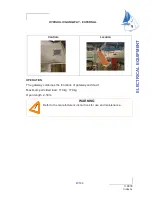
17
CHAPTER III:
COMMISSIONING AND DECOMMISSIONING
A. Initial Commissioning
The initial commissioning of your yacht is essentially the owner's responsibility. However, the
dealer may provide you with this service or recommend a yard which is competent in commissioning
Tayana yachts. The initial commissioning is extremely important. In addition to putting the yacht
into service, the following functions are also served: shipping damage is revealed. The trucking
company is liable for shipping damage, however, they require prompt notification of any claims
against them; part shortages are revealed, Tayana boxes the loose gear and provides a packing list,
but occasionally errors are made; and quality defects are revealed. Any damage at the destination
should be listed on the order receipt or bill of lading. Your yacht is thoroughly checked at the plant.
The quality program for each yacht includes a water drench test, functional testing of all systems, and
visual checks of the entire yacht. However, overseas and overland travel often causes leaks and other
problems which are difficult to detect by visual inspections alone. Engine delivery check-out service
is performed at the factory. However, the engine and the alignment of the power transmission system
should be re-checked after the yacht is launched.
The following functions should be performed during the initial commissioning. Detailed
procedures are described in their respective sections of this manual, and should be reviewed before
initiating commissioning.
1. Inspect hull, deck, rudder, propeller and shaft and spar for shipping damage.
2. Inventory all loose gear and report shortages or damaged parts.
3. Your yacht may have been partially winterized for winter shipment. Drain plugs will be found in a
bag in one of the lockers. Replace all drain plugs.
4. Install through-hull fittings for owner and/or dealer supplied equipment.
5. Prepare and paint bottom. All residues resulting from lay up and construction of hull must be
removed using a wax remover to ensure barrier and/or anti-foulant will adhere. For maximum anti-
fouling life, a full second coat of bottom paint is recommended.
6. Check continuity of zincs on shaft and keel. Continuity with all underwater fittings should also
be checked with a VOM meter.
7. Check, tighten hose clamps on all underwater fittings, and make sure they
=
re all double clamped.
8. Remove compass, or binnacle plate and tighten all bolts on shift and throttle linkages.
Содержание VANCOUVER 42
Страница 1: ...1 OPERATIONS AND MAINTENANCE MANUAL TAYANA VANCOUVER 42...
Страница 2: ...2 Tayana V 42 Center Cockpit Sailplan...
Страница 3: ...3 Tayana V 42 Aft Cockpit Interior Layout...
Страница 12: ...12 Figure II 1 Fiberglass Layout Schedule...
Страница 13: ...13 Figure II 2 V 42 Deck and Hull Joint...
Страница 19: ......
Страница 37: ...37 Figure IV 1 Fuel Supply Plumbing...
Страница 38: ...38 Figure IV 2 Fluid Plumbing System...
Страница 39: ...39 Figure IV 3 Center Cockpit Tankage Diagram...
Страница 43: ...43 TABLE IV 1 Direct Current Energy Audit...
Страница 48: ...48 Figure IV 6 Waste Water Plumbing System...
Страница 51: ...51 Figure IV 8 Propane System...
















































